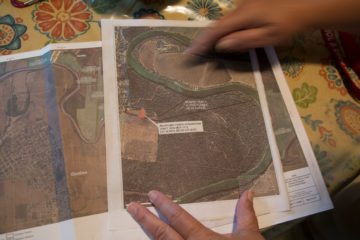Texans Receive First Notices of Land Condemnation for Trump's Border Wall
The government offered $2,900 for 1.2 acres near the Rio Grande. If Flores chooses not to accept the offer, the land could be seized through eminent domain.
The week before Donald Trump’s inauguration, Yvette Salinas received a letter she had been dreading for years: legal notice that the U.S. Department of Homeland Security (DHS) wants to build a border wall on her family’s land in Los Ebanos. The 21-page document, entitled a “Declaration of Taking,” is addressed to her ailing mother, Maria Flores, who owns the property with her siblings. The letter offers Flores $2,900 for 1.2 acres near the Rio Grande. If she chooses not to accept the offer, the land could be seized through eminent domain. “It’s scary when you read it,” Salinas says. “You feel like you have to sign.”
The 16-acre property has been in the family for so long that none of them can remember the year it was acquired. Salinas only knows they’ve had it for five generations. Her uncle runs a few head of cattle on the property, which lies not far from Los Ebanos’ most famous attraction, a hand-drawn ferry that shuttles cars and their passengers across the river to Mexico.
This is not the first time the federal government has wanted to seize the land for a border wall. In the wake of the Secure Fence Act of 2006, the Bush administration put up 110 miles of border fencing, much of it on private land in Texas. In 2008, Salinas’ family received a condemnation notice offering them the same low, low price of $2,900. Others in Los Ebanos were mailed similar notices.
But nature and time were on their side. Los Ebanos is squeezed into a bend in the Rio Grande, and lies entirely in the river’s floodplain. A treaty between the United States and Mexico forbids building any structures in the floodplain that could push floodwaters into surrounding communities.

Jen Reel
Salinas’ family held off on signing the condemnation letter. As time passed, building a wall in Los Ebanos seemed less likely, because of the treaty and because the Obama administration made wall-building less of a priority. In the meantime, Aleida Garcia, Salinas’ cousin, said the government has increased security in the area by adding more surveillance, which she prefers to Trump’s proposed 30-foot wall. “Even if they build a wall, people will still come,” said Garcia. “What’s helped us tremendously and is less expensive is the technology — the aerostat balloons, the ground sensors and even boots on the ground.”
But Los Ebanos appears to be a prime target for the Trump administration. The surveying and planning work has already been done, and the Secure Fence Act authorizes more border fencing to be built. And in 2012, the United States half of the International Boundary and Water Commission, a binational organization tasked with managing the U.S.-Mexico water treaty, capitulated to lobbying by DHS and agreed to a wall in the floodplain.

Jen Reel
Salinas says her family doesn’t want to give up their land, and they are consulting with lawyers to decide what to do next. But fighting the federal government could mean spending years in court. If they lose, DHS could take their land. Salinas, who is 29, says it makes her sad that the family’s legacy could be divided by an ugly wall that will cause problems for Los Ebanos. “We don’t want this wall — the town is pretty much united on that,” says Salinas. “But we don’t want to get sued by the U.S. government either.”
Correction: An earlier version of this article incorrectly stated that DHS could acquire Flores’ land through eminent domain without compensation. The government would, in fact, have to provide compensation for the land. The Observer regrets the error.












































No comments:
Post a Comment